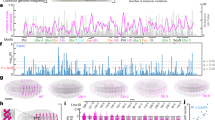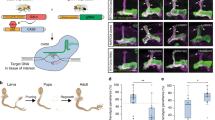Abstract
Presently there are no good assays for comparing somatic mutation frequencies and spectra between different vertebrate and invertebrate organisms. Here we describe a new lacZ mutation reporter system in D. melanogaster, which complements existing systems in the mouse. The results obtained with the new model indicate two-to threefold higher frequencies of spontaneous mutations than in the mouse, with most of the mutations characterized as large genome rearrangements.
This is a preview of subscription content, access via your institution
Access options
Subscribe to this journal
Receive 12 print issues and online access
$259.00 per year
only $21.58 per issue
Buy this article
- Purchase on Springer Link
- Instant access to full article PDF
Prices may be subject to local taxes which are calculated during checkout


Similar content being viewed by others
References
Vijg, J. Aging of the Genome (Oxford University Press, Oxford, 2007).
Russell, L.B., Selby, P.B., von Halle, E., Sheridan, W. & Valcovic, L. Mutat. Res. 86, 355–379 (1981).
Kaya, B., Marcos, R., Yanikoglu, A. & Creus, A. Mutat. Res. 557, 53–62 (2004).
Bielas, J.H. & Loeb, L.A. Nat. Methods 2, 285–290 (2005).
Castro, J.P. & Carareto, C.M. Genetica 121, 107–118 (2004).
Ranz, J.M., Casals, F. & Ruiz, A. Genome Res. 11, 230–239 (2001).
Curry, J., Karnaoukhova, L., Guenette, G.C. & Glickman, B.W. Genetics 152, 1065–1077 (1999).
Busuttil, R.A., Rubio, M., Dollé, M.E., Campisi, J. & Vijg, J. DNA Repair (Amst.) 5, 52–60 (2006).
Dollé, M.E. et al. Mutat. Res. 596, 22–35 (2006).
Acknowledgements
We thank P. Kapahi for critical comments and valuable suggestions. This work was supported by a grant from the US National Institutes of Health (AG20438).
Author information
Authors and Affiliations
Contributions
J.V. conceived, designed and supervised the study (initially with M.E.T.D.), obtained the funding and took the primary role in writing the manuscript. A.M.G. designed and performed most of the experiments, with A.D., assisted by R.B. and E.P. M.L. generated the transgenic flies (assisted by L.C.) and supervised the final experiments. R.B.C. provided statistical support.
Corresponding author
Ethics declarations
Competing interests
The authors declare no competing financial interests.
Supplementary information
Supplementary Fig. 1
Complete pCasper/pUR288-S nucleotide sequence. (PDF 47 kb)
Supplementary Fig. 2
Background mutant frequencies and spectra. (PDF 224 kb)
Supplementary Table 1
Sequenced size-change mutants recovered from line 11. (PDF 39 kb)
Rights and permissions
About this article
Cite this article
Garcia, A., Derventzi, A., Busuttil, R. et al. A model system for analyzing somatic mutations in Drosophila melanogaster. Nat Methods 4, 401–403 (2007). https://doi.org/10.1038/nmeth1027
Received:
Accepted:
Published:
Issue Date:
DOI: https://doi.org/10.1038/nmeth1027
This article is cited by
-
The various aspects of genetic and epigenetic toxicology: testing methods and clinical applications
Journal of Translational Medicine (2017)



